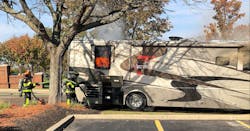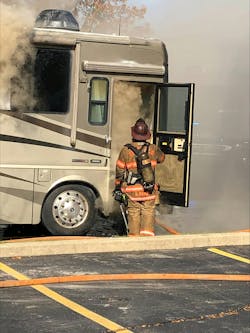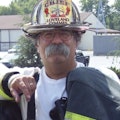Close Calls: Working ‘House’ Fire … on Wheels
Although there’s plenty to discuss about fires at single-family dwellings, they are common (read: high-frequency) responses that generally are moderate to high risk, depending on construction, staffing, location, water supply and other things that should be considered in a first-alarm assignment.
Then there are RV/motor home fires. Essentially a single-family dwelling fire that’s on wheels, you don’t know what’s inside. Yes, you generally know, but there always are predictable surprises, such as multiple families, storage, clutter and generators. This might sound like a single-family dwelling fire, but single-family dwellings must meet a fire code. RVs (not self-propelled) and motor homes (self-propelled) don’t have that requirement. There are recommended standards, such as NFPA 1192: Standard on Recreational Vehicles.
Because of the unique size, transport capabilities and use of RVs/motor homes, special provisions are needed to mitigate risks and to protect people and property. NFPA 1192 does that. It covers everything from smoke detection to means of egress, types of fire extinguishers and proper installation of systems for plumbing, fuel-burning and electrical.
Just like a single-family dwelling, there are no required inspections, so you get what you get. Unlike a fire at a single-family dwelling, when we arrive at a fire at an RV/motor home, there’s the chance that the dwelling can start to roll away.
From 2018–2020, about 4,200 U.S. RV/motor home fires were reported annually, according to the U.S. Fire Administration. Eighty-five percent of the fires occurred in motor homes. This column is about them.
Our sincere thanks to Mason, OH, Fire Department (MFD) Fire Chief Bryan Brumagen as well as Deerfield Township, OH, Fire Rescue Department (DTFR) Fire Chief Chris Eisele for their cooperation in the development of this column. Additionally, we thank MFD Lt. Julie Miller, MFD Deputy Chief Tom Wentzel, DTFR Lt. Ryan Haines, DTFR Deputy Chief Jason Todd and the crews of MFD Tower 52 (TO52) and DTFR Engine 56 (E56) and other units for their insight.
Account from Miller
TO52 and E56 arrived at the same time to find thick, brown smoke coming from the rear engine compartment of a Class A motor home. From the ground, the smoke level was at least head height.
TO52 and E56 had their own water supply (fully hydranted area) and 1¾-inch hose. TO52 began to apply water to the engine compartment in an attempt to cool it down and/or put out the fire. E56 was set up to go into the passenger’s front seat entrance, which was the only entrance.
There wasn’t much change in smoke conditions from the engine compartment. We had difficulty hitting it from the engine compartment access panel, so we opened a bigger area above it with a circular saw. I contacted E56’s officer to advise him that, based on my size-up, I thought that the fire was at the very rear of the unit and that the back wall and ceiling should be opened up.
I initially heard water flowing in the unit, but then it stopped. Fire and smoke became heavier throughout the interior and more turbulent. E56 called TO52 to ventilate the passenger’s side rear window.
TO52 vented the window. Heavy turbulent smoke came out and ignited the interior. E56 extinguished the fire from the inside.
Miller’s takeaways
The compartments that were on the outside of the unit needed to be investigated, because they housed electrical panels and hydraulic lines, among other things. Fire in these areas can spread easily into the interior. I wish that I investigated these sooner.
The best way to open up the exterior was with a circular saw because of the fiberglass construction of the siding. Note: Aluminum, wood, vinyl and steel siding construction also are common, so sizing up the exterior for tool selection is important.
In general, movement through motor homes (and RVs) is constricted, particularly when sliding compartments are open. When closed, these “slides” can hide access to bedrooms, bathrooms and cabinet spaces. One can find other hidden compartments, too. These two issues can combine to create problems. For example, when a bedroom slide is closed, the mattress can wedge against the interior, and removing the mattress to gain access to underneath storage is challenging.
Once confirmed that all occupants are out, if conditions worsen, access is further minimized, and locating the fire is even more difficult. Ventilate the motor home/RV to show the fire—the unit is totaled anyway—and then put out the fire.
Account from Haines
E56 arrived with Battalion 51 and TO52. The motor home was about 50 feet from a gas station. E56 positioned in the gas station out of traffic and established a water supply and stretched a 200-foot 1¾-inch preconnect because of the size of the motor home.
I did my size-up of the motor home and directed E56’s apparatus operator to place wheel chocks underneath the tires of the motor home.
Light smoke was noted from the vents on the top of the motor home. The occupant stated that everyone was out. An interior attack on the motor home was coordinated because of the proximity of the gas station and the lack of smoke from the exterior.
Members of the exterior crew (TO52) stated that they were in the process of working on opening the engine compartment under the rear of the motor home.
When the side entrance was opened, laminar (nonturbulent) light brown smoke was noted at the doorway, and visibility was good.
While the nozzle firefighter from E56 entered, I went ahead with the thermal imager and noted no significant heat, but smoke was present and was beginning to thicken toward the rear.
Owning a camper myself, I was aware of what to expect regarding egress and pocket doors that divide public areas from private areas. Noting the changing smoke but no heat, I opened the pocket door. A moderate heat condition presented itself. No fire was noted at this time, but I instructed the nozzle firefighter to open the line to cool the space.
Understanding the construction of the motor home was critical. While searching for the seat of the fire, I opened the door to the laundry room/bathroom. Fire presented from that area as well as from the sink area. That fire was extinguished.
Noticing that smoke conditions didn’t change, we backed the hoseline to the pocket door, and I called for the apparatus operator of TO52 to ventilate the rear window to clear the environ-
ment while my nozzle firefighter continued to flow the line.
Once the window was opened from the exterior, the fire that was in the rear bedroom was visible and was extinguished. The bed was lifted, and hidden compartments of fire were extinguished, and hot spots were taken care of.
Haines’ takeaways
The interior attack went as planned. Having first-hand knowledge of the construction and possible layouts of the vehicle was critical in the decision to make the attack from the interior.
Reflecting back on the incident, it might have been worthwhile for me to tell E56’s apparatus operator to set up a foam operation.
Having the nozzle firefighter open the line at the first sign of heat was critical in terms of allowing the space to get wet and changing the thermal balance that was within the compartment.
Observations from Todd
I was in my office when the run came in for E56 and TO52 responding to a report of an RV on fire. Units were on scene for a few minutes, including Battalion 51 (Wentzel), when a third engine, specifically Engine 51, was requestsed. It was then that I decided to respond to the scene.
Listening to radio traffic between Wentzel and Haines while responding, I could tell that the vehicle had to be a larger RV, with significant fire involvement.
When I arrived, most of the fire had been knocked down, and crews were in the overhaul phase of the operation. They had made several cuts around the rear of the motor home near the engine to extinguish any hidden fire.
We must treat these types of incidents as, essentially, homes on wheels. Larger motor homes/RVs can be as long as 45 feet and have nearly 400 sq. ft. of space. Having the appropriate staffing is crucial. The initial two engines, followed by the third engine, was a good call.
Establishing a water supply, stretching the appropriate size of attack lines and having incident command in place, as Wentzel accomplished, to monitor any changes that occurred on the outside of the motor home also were good decisions.
Motor homes and RVs present unique challenges and dangers. They have onboard propane systems, electrical systems, generators, bedrooms and small closets, and, in the case of motor homes, they have engines.
Account from Wentzel
We were responding to this reported RV on fire at a local gas station. Initial reports took us to the wrong location. (Our response district has several gas stations that have the same name.) Not long into the response, another responding unit arrived at the location, reporting nothing apparent.
Units were diverted to one of the other gas station locations. At the same time, one of our neighboring mutual-aid fire stations was listening to the call and auto-deployed, believing that it might end up being first on scene because of the error in the reported address.
Battalion 51, TO52 and E56 arrived at the correct address and found a motor home with heavy smoke showing in the rear of the vehicle. Smoke was heavy and pushing out of the main passenger-side occupancy entrance at the front of the vehicle.
TO52 deployed an attack line from its apparatus and began to flow water into the engine compartment access door on the rear of the vehicle. E56 deployed an attack line from its apparatus and made entry into the vehicle from the main passenger-side occupancy entrance.
I transmitted a scene size-up, established incident command, and directed police to shut down roads and divert traffic.
Crews were flowing water, but the smoke wasn’t changing as quickly as one would expect. This was a concern, because I knew that the crew that was on the interior was taking on a lot of smoke and heat.
Communication was good with the units that were on the fireground, and the fire wasn’t growing in intensity, but it wasn’t getting better either. For me, this was a growing concern from a firefighter safety perspective.
I called for an additional engine company, having one company essentially “interior.” To me, this was no different than a single-family dwelling that would have crews “on deck.” Also, knowing that there was a real possibility that the members of the initial crew might end up using up their air supply and might need to change bottles, another company could continue firefighting/overhaul without delay.
One of the windows at the rear of the motor home was taken out, which allowed for some ventilation. When this occurred, I believe that the interior crew realized that a door separated them from the rearmost compartment of the vehicle and that they hadn’t fully made the stretch to the rear of the motor home. They removed the door and located the main body of fire. Water was applied, and the fire went out.
Wentzel’s takeaways
We arrived at what was a mobile structure fire. Initially, the fire appeared to be in the engine compartment and might have burned into the interior based on smoke conditions on arrival. TO52 flowed water into the engine compartment and cut the rear fiberglass shell above the engine. Access was limited, and the area of fire origin wasn’t visible from the exterior, even after opening all of the exterior access storage doors and accessing the hard-mounted generator.
From an incident command safety perspective, the smoke was nasty, heavy and pushing out of the motor home at a decent rate. This put me in a defensive mindset, because this wasn’t a routine call for us.
With limited to no change in fire/smoke conditions, I had growing concerns for the firefighters’ safety, particularly for those inside. I wasn’t going to keep them inside much longer. As noted, motor home and RV fires aren’t routine for most departments. Diesel fuel, gas-charged struts, hydraulic fuel, electric circuits, and loads of fiberglass and plastic made this fire unusual and initially somewhat challenging.
I believed that we would extinguish this relatively quickly, but it turned out to be slightly more challenging. In hindsight, I should have called for another engine company as soon as I arrived. The extra staffing could have been helpful.
Otherwise, the incident went well.
Comments from Goldfeder
Although there certainly are unique factors when crews are operating at a motor home fire, so much of what we do normally when we arrive at any type of fire applies.
Our standard and expected (size-up and operational) factors include the time of day, life hazards (including members operating), arrangement/layout, conditions, area/size, height, construction, occupants, water supply, road hazards (note the chocking of the wheels on the motor home), weather and exposures. However, maintaining standard and basic operational behavior at an RV/motor home fire must be coupled with the unique circumstances of the response, which these firefighters did well.
So often, the question is asked, “What should we train on?” The answer is very clear: Whatever is in (or might be coming through) your response area. This incident provides all of us with one more incident to think and learn about.
About the Author
Billy Goldfeder
BILLY GOLDFEDER, EFO, who is a Firehouse contributing editor, has been a firefighter since 1973 and a chief officer since 1982. He is deputy fire chief of the Loveland-Symmes Fire Department in Ohio, which is an ISO Class 1, CPSE and CAAS-accredited department. Goldfeder has served on numerous NFPA and International Association of Fire Chiefs (IAFC) committees. He is on the board of directors of the IAFC Safety, Health and Survival Section and the National Fallen Firefighters Foundation.


